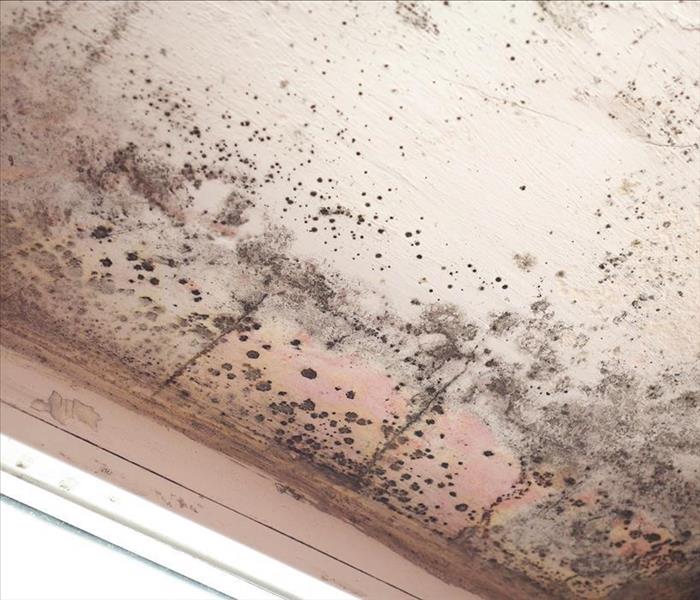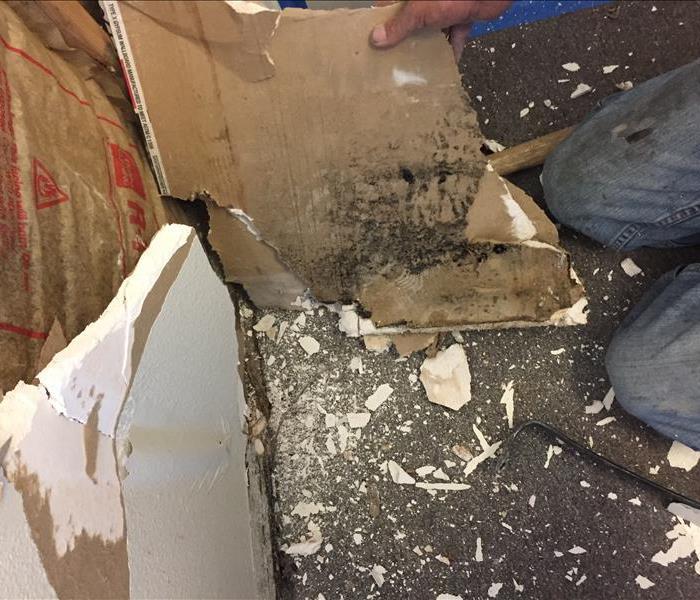Recent Mold Remediation Posts
Unveiling the Silent Threat: Recognizing Signs of Mold in Your Home
7/26/2023 (Permalink)
 mold in home
mold in home
Imagine coming home after a long day, and instead of being greeted by a warm, welcoming ambiance, you are met with a peculiar, musty odor. Your eyes may start to itch, or you might even experience respiratory issues. If you encounter any of these symptoms, it's time to delve deeper into a potential problem that could be lurking in your home: mold.
Mold is a common household problem that can pose serious health risks if left unchecked. It's not always visible, and its stealthy nature can lead to extensive damage to your property and even your well-being. To keep your home and loved ones safe, it's crucial to be aware of the signs of mold and know when to call in the professionals.
1. Musty Odor
One of the first indications of mold growth is a persistent musty smell in certain areas of your home. This odor often resembles damp or rotting wood and is particularly noticeable in basements, bathrooms, or other areas with poor ventilation. Don't ignore this unpleasant scent, as it could be an early warning sign that mold is present and actively spreading.
2. Visible Mold Spots
While some mold infestations may be concealed, others are quite apparent. Keep an eye out for visible mold growth on walls, ceilings, or floors. Mold can appear in various colors, including black, green, white, or even orange. It may present as fuzzy patches, small specks, or even slimy textures. Never disregard these visible signs, as they indicate a potentially more extensive problem underneath the surface.
3. Water Leaks and Damage
Mold thrives in moist environments, making water leaks a primary catalyst for its growth. Pay close attention to any signs of water damage, such as water stains on ceilings or walls, peeling paint, or warped surfaces. These areas are breeding grounds for mold, and prompt action is crucial to prevent further contamination.
4. Allergic Reactions
Mold can have adverse effects on human health, especially for those with allergies or respiratory conditions. If you or your family members experience unexplained allergic reactions such as sneezing, coughing, nasal congestion, skin rashes, or watery eyes, mold could be the culprit. Such symptoms may worsen when spending time in specific areas of your home, indicating mold presence.
5. Increased Humidity
Excess humidity in your home can create an ideal environment for mold to flourish. If your indoor spaces feel consistently damp or you notice condensation on windows and walls, it's essential to address the humidity issue promptly. Mold loves moisture, and controlling the humidity levels can help prevent its growth.
6. Health of Your Home
Mold doesn't just affect your health; it can also harm the structure of your home. Rotting wood, crumbling drywall, and weakening foundations are all potential consequences of long-term mold infestations. By paying attention to the well-being of your home, you can identify problems early on and take appropriate action.
Why You Should Call Professionals:
When dealing with mold, it's crucial to prioritize your safety and the well-being of your family. While minor mold issues can sometimes be remedied with DIY methods, larger infestations or hidden mold may require professional intervention. Here's why you should call professionals to remove mold:
1. Proper Identification and Elimination
Certified mold remediation professionals have the expertise and tools to accurately identify the type and extent of mold infestation. They can develop a comprehensive plan to eliminate the mold safely and effectively, preventing further spread.
2. Safety Measures
Mold removal involves handling potentially hazardous materials and using specialized equipment. Professionals follow strict safety protocols to protect themselves and your household during the remediation process.
3. Addressing the Root Cause
Professionals not only remove the visible mold but also address the underlying issues that caused the infestation in the first place. Whether it's repairing leaks or improving ventilation, they help ensure that mold won't return in the future.
4. Preventing Cross-Contamination
Improper handling of mold can lead to cross-contamination, spreading mold spores to unaffected areas of your home. Professionals employ containment strategies to prevent this from happening, safeguarding your living spaces.
In conclusion, mold can silently invade your home, posing health risks and causing structural damage. To protect yourself and your loved ones, keep an eye out for signs of mold and take action promptly. When faced with a substantial mold problem, always seek the help of certified professionals to ensure a safe and thorough mold remediation process. A mold-free home is not just a healthy home but a happy one too.
When Is Mold Remediation Covered by My Homeowner’s Insurance?
2/18/2021 (Permalink)
 Mold
Mold
No matter how meticulously you care for your home and prepare against disaster, damage can happen. In cases of water damage, which happen fairly often due to a leaking roof, broken pipes, or other incidents, it’s imperative that the damage is repaired quickly and a qualified mold remediation team is enlisted to ensure your home is free of fungus that can cause financial and health effects.
Dealing with a mold issue is already stressful, and the last thing you want is the added headache of remediation not being covered by insurance.
So when is mold remediation covered by homeowner’s insurance?
The short answer is that it varies by situation. An insurance company will only accept your claim if the need for mold remediation stems from something already covered in your policy.
When It’s Covered
Insurance policies will typically approve claims for mold remediation when the mold growth comes as a result of water damage that would also be covered on your policy. These situations can include malfunctioning appliances such as washing machines or refrigerators, a burst water heater, or as a result of a home fire being extinguished.
When It May Be Covered
Mold remediation may be covered when caused by weather factors. Flooding, a common cause of mold problems, is typically not included in the average homeowner’s insurance policy but can be purchased as add-on protection. This is typically recommended in high-risk coastal areas.
If your need for mold remediation arises from another kind of weather disaster, such as a hurricane, service may be covered depending on your policy and insurance provider.
When It’s Not Covered
Insurance companies will not cover mold remediation when it is necessitated by negligence and poor upkeep in a home. In other words, if the situation could have been prevented, a provider will typically choose not to cover remediation services. Examples of situations that fall under this category include spotting but ignoring a leaky pipe, window, etc. or failing to ensure adequate ventilation or install a humidifier in a consistently damp environment.
Mold remediation coverage may be capped at a specific dollar amount, so talk to your insurance provider to understand the specifics of your policy.
An issue with mold will often continue to grow and can create effects for your health. If you notice mold damage in your home, call a mold remediation team immediately, and read these tips for what to do while waiting for them to arrive.
If you’re located in the Cedar City or Fillmore, Utah areas, contact us at SERVPRO for cleanup and restoration services you can trust. Our highly-trained staff is on call 24/7 to respond to emergency situations, and will even work with your insurance company to streamline your claims process.
Understanding Mold Insurance Coverage
2/19/2020 (Permalink)
 Moldy drywall in Cedar City, UT home.
Moldy drywall in Cedar City, UT home.
Have you noticed fungus growth in your home, leaving you to wonder about mold insurance coverage? Unfortunately, most homeowner's policies do not cover mold damage in general, but there are specific circumstances where some coverage may be possible. However, to get the full benefit of your policy, it is necessary to understand four aspects of mold insurance coverage.
Mold Insurance Coverage
- Peril coverage
- Mold caps
- Preventable damage
- Professional inspections
Peril Coverage
When it comes to a typical homeowner policy, the mold coverage is likely limited to listed perils. In other words, if your home develops a mold problem because of a fire or sudden pipe break, then mold removal may be covered, but the specifics will need to be addressed by an adjuster.
Mold Caps
There are some policies the will cover a portion of the removal of fungus growth. However, these specific policies likely have strict caps on coverage limits. Therefore, while your plan may include some of the damage, you will typically still be required to pay a portion of the removal and remediation expense.
Preventable Damage
Regardless of how your policy handles mold claims, a claim is likely to be rejected or denied if the damage incurred is determined to have been avoidable or due to negligence. For example, if you failed to fix a leak or if you didn't clean your gutters resulting in roof damage and leading to mold.
Professional Inspections
While some insurance policies will cover some mold damage, the best option for homeowners is prevention. Therefore, stick to annual home inspections by a professional remediation company in Cedar City, UT. Being diligent about inspections should allow you to prevent most water-related issues, protecting your home from the risk of mold.
While fungus growth is a common problem for homeowners, it is necessary to understand the most homeowners' policies do not cover mold damage. However, there are specific situations where coverage is possible, but the best practice is still prevention.
What is in your air?
6/28/2019 (Permalink)
Mold is that four letter word that you can’t escape from. Mold is everywhere, outside, inside, and in the air we breathe. Our houses are no exception when it comes to mold. There are different types of mold and mold can be found in different levels of concentration some of types of mold or amounts of mold are not as harmful as other types and amounts.
At SERVPRO of Cedar City/Fillmore we are always concerned about your health, and want to ensure that you are in a safe living environment. We can take air and swab samples from your home and have them tested in a lab to ensure that you do not have an unhealthy concentration of harmful mold in your home. Our technicians are skilled and able to quickly take the necessary steps to ensure that the air in your home is properly tested. If it turns out that you do have an unsafe amount of mold in your home, we provide professional mold remediation services to help ensure you are able to live in a safe environment.
If you are not sure about the air in your home or suspect that you might have mold call SERVPRO of Cedar City/Fillmore today. 435-251-9241
Mold? In a dry climate?
11/14/2017 (Permalink)
Simply put mold is not something that you want growing in your home. Many people in Southern Utah do not have large concerns about mold and wonder why we spend so much time talking about it. Southern Utah is a dry desert climate many people think that mold is not a problem here. Often mold is not as big of a problem in Southern Utah as it is in more humid areas, but there are situations home owners encounter that drastically increase the potential for mold growth. In Southern Utah one of the biggest causes of mold growth in homes comes from flooding or water leaks in homes that are not mitigated properly.
People often want to save money especially when it comes to an unplanned emergency expense. This is very understandable as proper mitigation for water problems in a home is not always inexpensive. One thing to consider in this case is that the expense of proper mold remediation is usually more expensive than the cost of water mitigation, and the preventable mold growth in your home can create an environment that is hazardous to your health.
When you encounter unwanted water problems in your home it is important to have the professionals at SERVPRO of Cedar City/Fillmore properly mitigate them so that you can avoid the hazards of mold growth from improper mitigation or the water problems. If you find mold in your home, a water leak, or flooding in your home don’t hesitate, call SERVPRO of Cedar City/Fillmore at 435-251-9241.
Mold Safety Tips
5/12/2017 (Permalink)
Be careful! Without proper training, you could be spreading mold throughout your home.
If you see visible mold, do not disturb it. You can inadvertently spread the mold infestation throughout your home. When mold is disturbed, the mold can release microscopic mold spores which become airborne and can circulate inside your home.
What to Do:
- Stay out of affected areas.
- Turn off the HVAC system and fans.
- Contact SERVPRO of Cedar City/Fillmore for mold remediation services.
What Not to Do:
- Don’t touch or disturb the mold.
- Don’t blow air across any surfaces with visible or suspected mold growth.
- Don’t attempt to dry the area yourself.
- Don’t spray bleach or other disinfectants on the mold.
About Our Mold Remediation Services
SERVPRO of Cedar City/Fillmore specializes in mold cleanup and restoration, in fact, it’s a cornerstone of our business. Our crews are highly trained restoration professionals that use specialized equipment and techniques to properly remediate your mold problem quickly and safely.
If You See Signs of Mold, Call Us Today
(435)251-9241



 24/7 Emergency Service
24/7 Emergency Service

